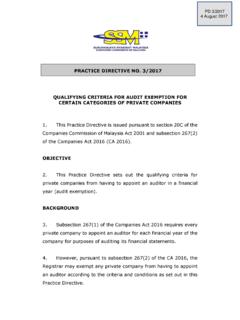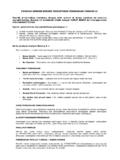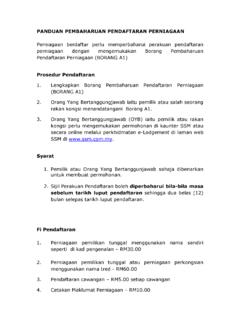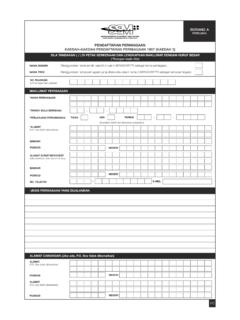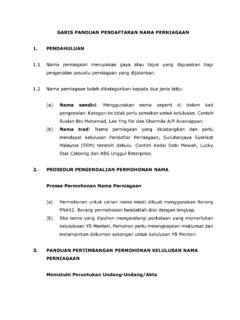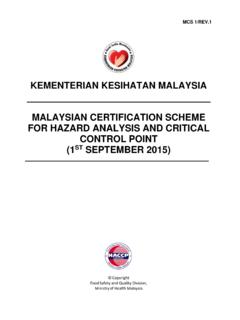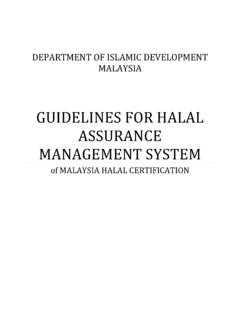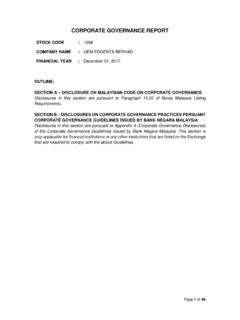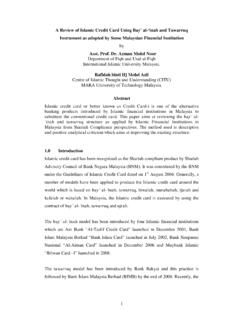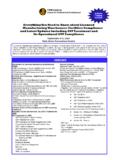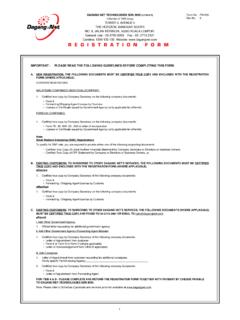Transcription of BACKGROUND TO THE REVIEW PROCESS AND …
1 1 FAQS ON THE companies ACT 2016 (ACT 777) BACKGROUND TO THE REVIEW PROCESS AND NEW malaysian companies ACT 1. When was the REVIEW PROCESS of the companies Act initiated? The structured REVIEW PROCESS of the companies Act actively began in December 2003 when SSM established the Corporate Law Reform Committee (CLRC). The CLRC was part of SSM s Strategic Direction initiatives formulated in 2003 to develop a dynamic and conducive regulatory environment for businesses in Malaysia. 2. What were the objectives for the establishment of CLRC? SSM established the CLRC to spearhead the REVIEW of the companies Act 1965 with the following main objectives: To create a legal and regulatory structure that will facilitate business; and To promote accountability and protection of corporate directors and members taking into account the interest of other stakeholders, in line with international standards.
2 3. Are there any other factors that were taken into account by CLRC in recommending the changes to be made to the companies Act besides the objectives stated above? When reviewing and recommending changes to the companies Act, the CLRC considered the following factors: Modernising the law by taking into account the advances made in information and communication technology (ICT); Reducing the costs of compliance; Reducing duplications and conflicts that exists between the various corporate regulatory bodies; Simplifying the existing operational processes of a company; and 2 Simplifying the current legislative language as used in the Act.
3 4. Was the public consulted during the PROCESS of formulating recommendations of changes to the companies Act by CLRC? Yes, public consultation was extensively conducted during the REVIEW PROCESS . The CLRC had, throughout the Law Reform Programme, issued a total of 12 consultative documents for public consultation. Such consultation PROCESS is vital to ensure that the views and feedback of the industry and stakeholders are taken into consideration when formulating the recommendations. This is especially important since the proposed recommendations will have a direct impact on the business community. The views and feedback play a significant part in ensuring that the proposed recommendations will facilitate and promote business growth.
4 5. What were the outcomes of the reform PROCESS conducted by CLRC? The outcome was encapsulated in CLRC Final Report which contained 188 Recommendations to SSM. The Final Report proposed changes that should be implemented to the companies Act. After due consideration, SSM s Board formally accepted 183 out of the 188 recommendations, which were then consolidated into 19 Policy Statements which formed the basis for the companies Act 2016. 6. What were the scope and issues covered in the 188 Recommendations by CLRC? The CLRC s recommendations covered all aspects of the legal framework relating to the administration of companies ranging from inception of a company (preliminaries & incorporation PROCESS ), life span (management, capital, shares, charges, corporate governance up to its demise (winding-up, striking-off & dissolution).)
5 3 Issues related to good governance, shareholders protection, enforcement and sanctions were also carefully considered and included. 7. What were the 19 Policy Statements formulated based on the CLRC s Recommendations? Modernizing the companies Act; Facilitating & Modernizing Entrance into the Corporate Sector; Migration to No Par Value Regime; Facilitating the Management & Restructuring of the Company s Share Composition; Simplifying & Facilitating Internal Decision Making PROCESS ; Strengthening the Corporate Governance Structure in Relation to the Affairs of the Directorship of a Company; Reinforcing The Roles, Functions & Obligations of the Company Secretaries; Establishment of a Registration Regime for Practicing Company Secretaries.
6 Integrating the Contents of the New companies Act with the Notions & Elements of Corporate Responsibility; Enhancement of Shareholders Rights & Protection; Strengthening the Corporate Governance Structure Through Refinement of Auditors Role & Responsibilities; Reaffirming the Importance of Audited Financial Statements & the Timely Disclosure of such Information; Strengthening Good Corporate Governance Practices Through Enhancement & Refinement of Rules Pertaining to Transactions Involving Directors & Substantial Shareholders; 4 Simplifying, Refining & Expediting the Winding Up PROCESS ; Modernizing Insolvency Law by Introducing Corporate Rescue Mechanisms to Revive Financially Troubled companies ; Restructuring the Concept of Scheme of Arrangements Between a Company and its Creditors; Refining The Role of Receivers/Receiver & Managers; Refining the Current System of Registration of Charges by Improving the Procedures and Processes Involved; and Modernizing the Enforcement Regime.
7 8. What are the basic philosophies adopted in modernizing the malaysian companies Act? The introduction of a new legal framework applicable to all companies ; Simplifying laws and procedures for companies based on private/public distinction and facilitating the growth of private companies ; and Removing obstacles and facilitating the growth of private companies . 9. Are there any provisions that will be introduced to facilitate and modernize the entrance into the corporate sector? Yes. In order to facilitate and modernize the entrance into the corporate sector, the following provisions will be introduced: Conferment of companies with full capacity of a natural person.
8 However, companies may elect or decide to have their object clauses should they wish to limit their capacity. Notwithstanding, non-profit making companies would still be required to specify their objects. Introduction of the concept of a single member company where a company can be incorporated by only one member and that member can also be the director; and 5 Fees to incorporate a company will be based on the type of companies . 10. What are the new provisions introduced under the companies Act 2016 to remove the obstacles in incorporating a company? The PROCESS of incorporating a company currently consists of several procedures thus making the incorporation PROCESS becomes unduly complicated and may be seen as unnecessary obstacles.
9 By examining the whole PROCESS , some of the procedures could be simplified or removed to provide simple and easy incorporation PROCESS . Under the current regulatory structure, the current company s name reservation PROCESS will be made optional by introducing the guaranteed name approval concept. Through the guaranteed name approval PROCESS , persons intending to incorporate a company will have the option to use the name they have proposed or if such name is not approved, to use the company s registration number (as a temporary measure). Removing the requirement for Memorandum & Articles at the point of incorporation.
10 A company will have the option whether to adopt its own Articles of Association and such adoption could be done after its incorporation. In view of this, some provisions contained in the current Table A are adopted as substantive law. To further simplify the incorporation PROCESS , all statutory declaration by Promoters/Directors which previously required to be executed before a Commissioners of Oath is now replaced with statement of compliance. At the same time, the law also liberalise the qualification of secretaries to include directors. Directors can also act as secretaries for private companies (PROVISO: same person cannot act as both director/secretary relating to actions that require to be done by both a director and secretary).
